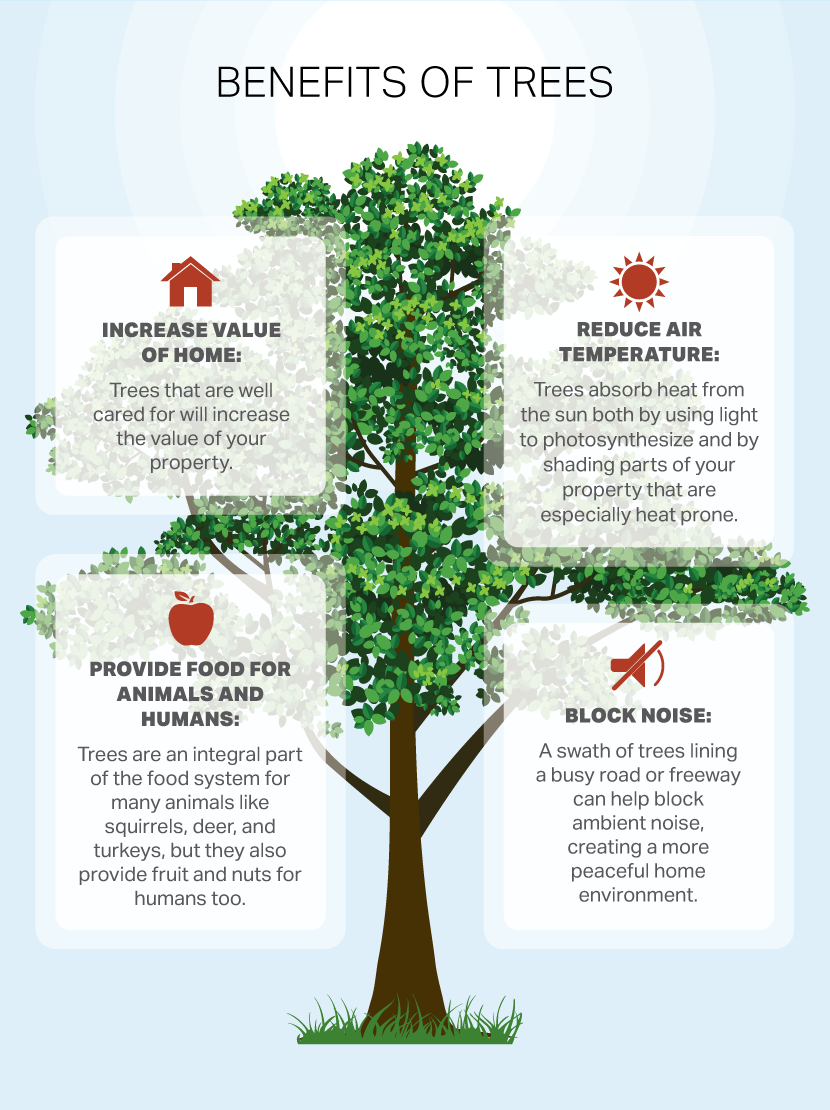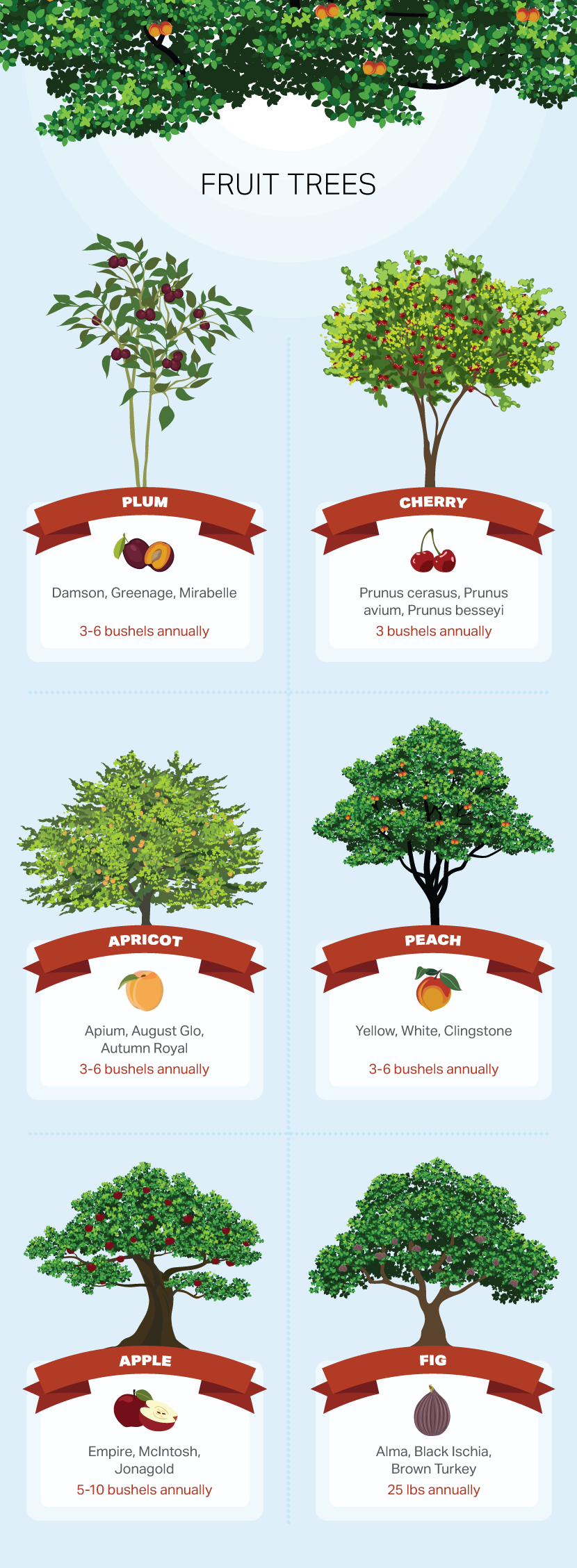How to Choose a Tree For Your Yard or Garden
When it comes to veggies, houseplants, or ornamental gardens, most of us have an idea of what we should grow. But we walk through our environment every day and never consider some of the largest plants, even though they’re staring us right in the face.
Adding trees to your yard, garden, or landscaping is an often-overlooked option. It’s a shame, because trees offer benefits that many other plants don’t provide – shade, increased property value, and fruits and nuts for years to come.

It’s impossible to cover all the benefits to having healthy trees on your property. Yes, they’re beautiful. Yes, they provide shade. But they have so many other positives:
Reduce Air Temperature: Trees block sunlight, absorbing it instead of allowing it to hit your pavement, soil, or structures. Many homeowners think the main purpose is shade, without thinking of the heat reduction that comes along with it.
On top of that, when the morning dew evaporates from the surface of a tree’s leaves, they cool down the air even further. A double whammy of cooling potential – especially useful if you’re in an area that usually gets blasted by heat.
Block Noise and Glare: Trees are nature’s solution to noisy freeways and roads. By planting a large swath of trees against a busy road or freeway, you can mitigate the noise. On top of that, the glare and reflected light from cars and other man-made surfaces is reduced significantly by adding a tree barrier to your home.
Increase Value of Home: Unlike many other plants you can add to your home, trees can add anywhere from 5 to 15 percent to the value of your home. Provided it’s well-landscaped on top of having healthy, mature trees, you’ll notice a significant property value boost. This makes sense – it takes a lot of time and effort to maintain healthy trees, and they look absolutely beautiful. Your home price should go up to reflect that reality.
Provide Food for Animals and Humans: If you value having a productive yard, opt for trees that provide food, whether for yourself or the animals that hang around your property. If you’re a big gardener, the value of having productive trees is twofold: You can harvest fruits and nuts from trees for years once they are established, and you support other beneficial critters and birds in your environment.

If you’re just now considering establishing trees in your yard, you’ve got some work to do. Trees are some of the slower-growing plants you can add to your landscaping, but don’t fear – there are some wonderful types that grow quickly (for a tree):
Hybrid Poplar: There’s a reason that homebuilders plant a lot of hybrid poplars – they grow fast. They can grow up to eight feet a year and top out at 40 to 50 feet, meaning it can take four to five years for them to get to an impressive size. They need to be planted at least 10 feet apart from each other, and don’t require much care. Use them strategically to create a beautiful, oval-shaped hedge against noise or light, or just to create a nice-looking hedge. The most popular variety is Populus deltoides x Populus nigra.
Red Maple: Red maples have some of the most vibrant colors you’ll find on a fast-growing tree. With a bright, deep red, it’s the quintessential fall tree. On top of that, it grows anywhere from two to five feet per year, topping out at around 40 feet tall. Red maples make a wonderful shade tree, but are also a source of leaves in the fall, which you can use to make leaf mold or compost.
Weeping Willow: This is the classic shade tree, known for the sweeping branches that droop or “weep” along the ground’s surface. Weeping willows also happen to be one of the faster-growing shade trees at around six to eight feet per year, putting out a wonderfully beautiful canopy along the way. Weeping willows prefer to be planted against a riverbank or water source, but they can survive even in drought-stricken areas with proper irrigation technique.
American Sycamore: The American sycamore, often just referred to as sycamore in America, grows up to six feet per year and tops out at an astounding 100 to 130 feet tall if grown in perfect conditions. This makes it one of the largest shade plants on the list, but don’t be discouraged – you can still get plenty of value from smaller sycamore trees.
Paper Birch: If you’re looking for an unusual-looking tree, choose the paper birch. Its name comes from its white, flaky bark, which adds a beautiful contrast to the otherwise brown bark of most trees. It grows around one to two feet per year, which is slower that some of the other trees we’ve covered so far. That said, it tops out at around 50 to 70 feet, higher than many others.
Nuttall Oak: The Nuttall oak is one of the fastest-growing oak trees you can plant and tops out at around 40 to 60 feet tall. It’s a wonderful shade tree, but what makes it unique in this list is its ability to be a food source for squirrels and other critters.

Not all trees need to be used solely for shade or to increase property value. One of the best reasons to add trees to your yard is to increase the food you produce from your own property. Fruit trees are a wonderful way to do this, and are less complicated to grow than you might think.
Plum Tree
Plums are a fantastic beginner fruit tree for gardeners who are just getting starting growing fruits. They grow in most regions, are compact, and don’t require too much care compared to other fruit trees. The biggest tip for growing plum trees is to plant more than one variety of plum, because they’ll need to cross-pollinate to set fruit properly. If you don’t do this, you could find yourself with a beautiful-looking plum tree…but no fruit!
Cherry Trees
When growing cherries, the first question you must answer is, “What type of cherry will I grow?” There are tart and sweet cherry varieties. Tart cherries are typically grown for use in baked goods such as pies, while sweet cherries are grown to be eaten as is. If you decide to grow sweet cherries, the same rule of thumb as growing plums applies – plant multiple cultivars for cross-pollination.
Apricot Trees
Unlike some of the other fruit trees we’ve covered so far, apricots are self-fruiting. This means they don’t need another tree to set fruit properly, making them easy for beginner fruit growers. They don’t need much to do well – a temperate climate and fertile soil is more than enough to get them producing.
Peach Trees
Ah, peaches. One of the most delicious fruits you can grow, in my humble opinion. These trees grow to about 15 feet tall unless you get a dwarf variety, which grows to about 6 feet tall. They take about three to five months to produce fruit and, once established, will produce for a little over a decade. Getting a few peach trees established in your yard now will pay delicious dividends for years to come.
Apple Trees
Apples are the quintessential fruit, and a great one to grow even if you’re a beginner in growing fruit trees. If you have limited space, select a dwarf variety and grow it in a container. You just need to make sure you select a variety that will tolerate your specific climate, so call your local extension service and ask them which varieties thrive in your area.
Fig Trees
In my opinion, there’s no more satisfying fruit to grow than the humble fig. It’s unlike most fruit trees in that it produces a fruit of a completely different texture than a berry, apple, or stonefruit. If you decide to grow figs, choose the common fig tree as it has all female flowers, meaning they will pollinate themselves and you don’t have to plant another fig tree for cross-pollination.
Trees are a wonderful addition to your yard, whether you’re growing them for economic, practical, or productive reasons. In a perfect world, you’d have trees dotting your property that fulfilled these functions! Whichever you choose, let this be your guide to getting started with trees on your property.
Embed the article on your site

























































